Study of the Influence of Dynamic and Static Capillary Forces on Production in Low-Permeability Reservoirs
Abstract
:1. Introduction
2. Methodology
2.1. Calculation Method of Dynamic and Static Capillary Force
2.2. Measuring Method of Static and Dynamic Capillary Force
2.3. Capillary-Force Test Results
3. Numerical Model of Low-Permeability Reservoir Considering Dynamic Capillary Force
- (1)
- The fluid in the reservoir is the oil and the water phase and the wetting phase is water and the oil phase is non-wetting phase.
- (2)
- The seepage process conforms to the Darcy law.
- (3)
- The fluid in the reservoir is isothermal seepage; the temperature does not change with time.
- (4)
- Pressure gradient affects the seepage process.
- (5)
- Dynamic capillary force and gravity affect the seepage process.
4. Results and Discussion
4.1. Effect of Formation Pressure
4.2. Influence of Heterogeneity
4.3. Influence of Development Intensity
5. Conclusions
- The capillary force of the reservoir is not only related to the static factor of wetting-phase saturation, but also to the dynamic factor of the change of saturation with time. The experiment proves that dynamic capillary force is greater than static capillary force, and there is a linear relationship between and . The dynamic capillary force coefficient τ = 0.2008 is obtained by fitting the experimental data.
- In low-permeability reservoirs, there are differences between the predicted results of dynamic and static capillary-force seepage models. Compared with the static capillary force, the dynamic capillary force will continuously enhance the heterogeneity of the reservoir and increase the oil-phase seepage resistance. The predicted water cut will increase faster, and the recovery ratio will decrease.
- Initial formation pressure and development time have influence on the effect of dynamic capillary force. With the increase in reservoir burial depth and formation pressure, the effect of dynamic capillary force is more obvious. As the reservoir enters the middle and late development stages, the effect of dynamic capillary force is gradually highlighted.
- The effect of dynamic capillary force is different in different heterogeneous reservoirs. The horizontal heterogeneity of a reservoir will strengthen the effect of the dynamic capillary force, while the vertical heterogeneity will weaken the effect of dynamic capillary force. In other words, in the process of water flooding in low-permeability reservoirs, when the horizontal spread range is inhomogeneous, the dynamic capillary force effect is obvious; when the vertical spread range is inhomogeneous, the effect of dynamic capillary force is not obvious.
- The greater the production rate, the greater the prediction error of static capillary force seepage model, which is more obvious in horizontal heterogeneous reservoirs. After using the dynamic capillary-force seepage model, the predicted recovery error of horizontal heterogeneous reservoir can reach 2.4%, 3.5%, and 4.7% at the production rate of 8, 11, and 14 m3/d, respectively. Therefore, the low-permeability reservoir with strong horizontal heterogeneity should pay more attention to the dynamic capillary force.
Author Contributions
Funding
Informed Consent Statement
Data Availability Statement
Acknowledgments
Conflicts of Interest
Nomenclature
| capillary force, MPa | |
| oil–water interfacial tension, N/m | |
| wetting angle, degree | |
| pore radius, mm | |
| oil-phase pressure, MPa | |
| water-phase pressure, MPa | |
| wetting-phase saturation, decimal | |
| time, s | |
| dynamic capillary force, MPa | |
| static capillary force, MPa | |
| dynamic capillary-force coefficient, MPa·s | |
| formation permeability, mD | |
| relative permeability of oil phase, decimal | |
| relative permeability of oil phase, decimal | |
| density of oil phase, kg/m3 | |
| density of water phase, kg/m3 | |
| rate of oil phase, m3/d | |
| porosity, decimal | |
| saturation of oil phase, decimal | |
| saturation of water phase, decimal |
References
- Abbasi, J.; Ghaedi, M.; Riazi, M. A new numerical approach for investigation of the effects of dynamic capillary pressure in im-bibition process. J. Pet. Sci. Eng. 2018, 162, 44–54. [Google Scholar]
- Tian, S.; Lei, G.; He, S.; Yang, L. Dynamic effect of capillary pressure in low permeability reservoirs. Pet. Explor. Dev. 2012, 39, 405–411. [Google Scholar] [CrossRef]
- Civan, F. Temperature dependency of dynamic coefficient for nonequilibrium capillary force-saturation relationship. Aiche J. 2012, 58, 2282–2285. [Google Scholar]
- Sander, G.C.; Glidewell, O.J.; Norbury, J. Dynamic capillary pressure, hysteresis and gravity-driven fingering in porous media. J. Phys. Conf. Ser. 2008, 138, 012023. [Google Scholar] [CrossRef]
- Korayem, M.; Kavousi, A.; Ebrahimi, N. Dynamic analysis of tapping-mode AFM considering capillary force interactions. Sci. Iran. 2011, 18, 121–129. [Google Scholar] [CrossRef]
- Yan, C.Z.; Xiu-Sheng, L.I.; Chang, Y.W.; Li-Jun, Y.U.; Shi, J.Z. Development of low permeability reservoir with closely-spaced wells. Petrol. Explor. Dev. 2005, 32, 105–107. [Google Scholar]
- Hassanizadeh, S.M.; Gray, W.G. Toward an improved description of the physics of two-phase flow. Adv. Water Resour. 1993, 16, 53–67. [Google Scholar] [CrossRef]
- Hassanizadeh, S.M.; Celia, M.A.; Dahle, H.K. Dynamic effects in the capillary force–saturation relationship and its impact on unsatuvelocity d flow. Vadose Zone J. 2002, 1, 38–57. [Google Scholar]
- Joekar-Niasar, V.; Hassanizadeh, S.M.; Dahle, H.K. Non-equilibrium effects in capillarity and interfacial area in two-phase flow: Dynamic pore-network modelling. J. Fluid Mech. 2010, 655, 38–71. [Google Scholar] [CrossRef]
- Wang, S.; Liu, P.; Zhao, H.; Zhang, Y. A novel method for calculating the dynamic capillary force and correcting the pressure error in micro-tube experiment. Sci. Rep. 2017, 7, 16590. [Google Scholar] [CrossRef]
- Helmig, R.; Weiss, A.; Wohlmuth, B.I. Dynamic capillary effects in heterogeneous porous media. Comput. Geosci. 2007, 11, 261–274. [Google Scholar] [CrossRef]
- Hassanizadeh, S.; Gray, W.G. Mechanics and thermodynamics of multiphase flow in porous media including interphase boundaries. Adv. Water Resour. 1990, 13, 169–186. [Google Scholar] [CrossRef]
- Barenblatt, G.I.; Patzek, T.W.; Silin, D.B. The Mathematical Model of Nonequilibrium Effects in Water-Oil Displacement. SPE J. 2003, 8, 409–416. [Google Scholar] [CrossRef]
- Das, D.B.; Mirzaei, M. Dynamic effects in capillary force relationships for two-phase flow in porous media: Experiments and numerical analyses. Aiche J. 2012, 58, 3891–3903. [Google Scholar] [CrossRef] [Green Version]
- Li, Y.; Liu, C.; Li, H.; Chen, S.; Lu, K.; Zhang, Q.; Luo, H. A review on measurement of the dynamic effect in capillary pressure. J. Pet. Sci. Eng. 2022, 208, 109672. [Google Scholar] [CrossRef]
- Bear, J. Dynamics of Fluids in Porous Media; American Elsevier Publishing Company Inc.: New York, NY, USA, 1988; ISBN-13: 978-0-486-65675-5. [Google Scholar]
- Das, D.B.; Hanspal, N.S.; Nassehi, V. Analysis of hydrodynamic conditions in adjacent free and heterogeneous porous flow domains. Hydrol. Process. 2005, 19, 2775–2799. [Google Scholar] [CrossRef]
- Kalaydjian, F. Effect of the Flow rate on an imbibition capillary pressure curvetheory versus experiment. In SCA European Core Analysis Symposium; Institute Francais du Petrole: Rueil-Malmaison, France, 1992; pp. 175–194. [Google Scholar]
- Bhusan, D.; Mirzaei, M. Experimental measurement of dynamic effect in capillary pressure relationship for two-phase flow in weakly layered porous media. AIChE J. 2013, 59, 1723–1734. [Google Scholar]
- Bottero, S.; Hassanizadeh, S.M.; Kleingeld, P.J.; Heimovaara, T.J. Non-equilibrium capillarity effects in two-phase flow through porous media at different scales. Water Resour. Res. 2011, 47, 10. [Google Scholar] [CrossRef]
- Hanspal, N.S.; Das, D.B. Dynamic effects on capillary pressure–Saturation relationships for two-phase porous flow: Implications of temperature. AIChE J. 2011, 58, 1951–1965. [Google Scholar] [CrossRef]
- Blank, L.; Rioseco, E.M.; Caiazzo, A.; Wilbrandt, U. Modeling, simulation, and optimization of geothermal energy production from hot sedimentary aquifers. Comput. Geosci. 2020, 25, 67–104. [Google Scholar] [CrossRef]
- Salimi, H.; Bruining, J. Upscaling of fractured oil reservoirs using homogenization including non-equilibrium capillary force and relative permeability. Computat. Geosci. 2012, 16, 367–389. [Google Scholar] [CrossRef]
- Mikelić, A. A global existence result for the equations describing unsatuvelocity flow in porous media with dynamic capillary force. J. Differ. Equ. 2010, 248, 1561–1577. [Google Scholar]
- Camps-Roach, G.; O’Carroll, D.M.; Newson, T.A.; Sakaki, T.; Illangasekare, T.H. Experimental investigation of dynamic effects in capillary force: Grain size dependency and upscaling. Water Resour. Res. 2010, 46, 863. [Google Scholar]
- Juanes, R. Nonequilibrium effects in models of three-phase flow in porous media. Adv. Water Resour. 2008, 31, 661–673. [Google Scholar] [CrossRef]
- Fuík, R.; Mikyka, J.; Sakaki, T.; Bene, M.; Illangasekare, T.H. Significance of dynamic effect in capillarity during drainage experiments in layered porous media. Vadose Zone J. 2010, 9, 697–708. [Google Scholar]
- Hajibeygi, H.; Lunati, I.; Lee, S.H. Accuvelocity and efficient simulation of multiphase flow in a heterogeneous reservoir with error estimate and control in the multiscale finite-volume framework. SPE J. 2012, 17, 1071–1083. [Google Scholar]
- Manthey, S.; Hassanizadeh, S.M.; Helmig, R. Macro-Scale Dynamic Effects in Homogeneous and Heterogeneous Porous Media. Transp. Porous Media 2005, 58, 121–145. [Google Scholar] [CrossRef]
- Mirzaei, M.; Das, D.B. Dynamic effects in capillary force–saturations relationships for two-phase flow in 3D porous media: Implications of micro-heterogeneities. Chem. Eng. Sci. 2007, 62, 1927–1947. [Google Scholar] [CrossRef]
- Peszyńska, M.; Yi, S.-Y. Numerical methods for unsatuvelocity d flow with dynamic capillary force in het-erogeneous porous media. Int. J. Numer. Anal Mod. 2008, 5, 126–149. [Google Scholar]
- Lv, C.; Wang, J.; Sun, Z.G. An experimental study on starting pressure gradient of fluids flow in low permeability sandstone porous media. Petrol. Explor. Dev. 2002, 29, 86–89. [Google Scholar]
- Xu, M.A.; Tian, S.B.; Zhou, S.W.; Lei, G. Investigation of the effect of dynamic capillary force on water flooding in ultra-low permeability reservoirs. Sci. Technol. Eng. 2015, 15, 153–155. [Google Scholar]
- Liu, P.; Yuan, Z.; Li, K. An improved capillary force model using fractal geometry for coal rock. J. Pet. Sci. Eng. 2016, 145, 473–481. [Google Scholar]
- Beliaev, A.Y.; Hassanizadeh, S.M. A Theoretical Model of Hysteresis and Dynamic Effects in the Capillary Relation for Two-phase Flow in Porous Media. Transp. Porous Media 2001, 43, 487–510. [Google Scholar] [CrossRef]
- Beliaev, A.Y.; Schotting, R.J. Analysis of a new model for unsatuvelocity d flow in porous media including hysteresis and dynamic effects. Computat. Geosci. 2001, 5, 345–368. [Google Scholar]
- O’Carroll, D.M.; Phelan, T.J.; Abriola, L.M. Exploring dynamic effects in capillary force in multistep outflow experiments. Water Resour. Res. 2005, 41, 312–329. [Google Scholar]
- Abidoye, L.K.; Das, D.B. Scale dependent dynamic capillary force effect for two-phase flow in porous media. Adv. Water Resour. 2014, 74, 212–230. [Google Scholar] [CrossRef] [Green Version]
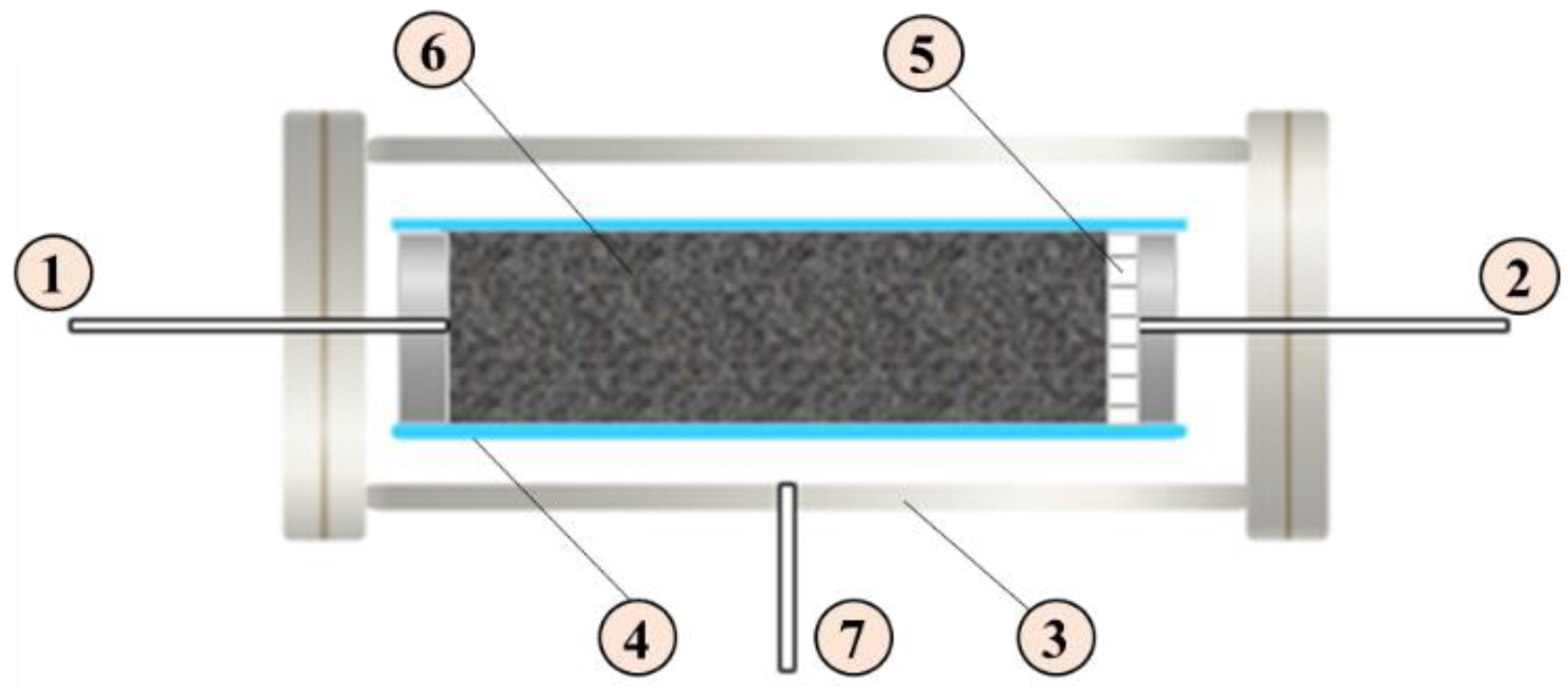
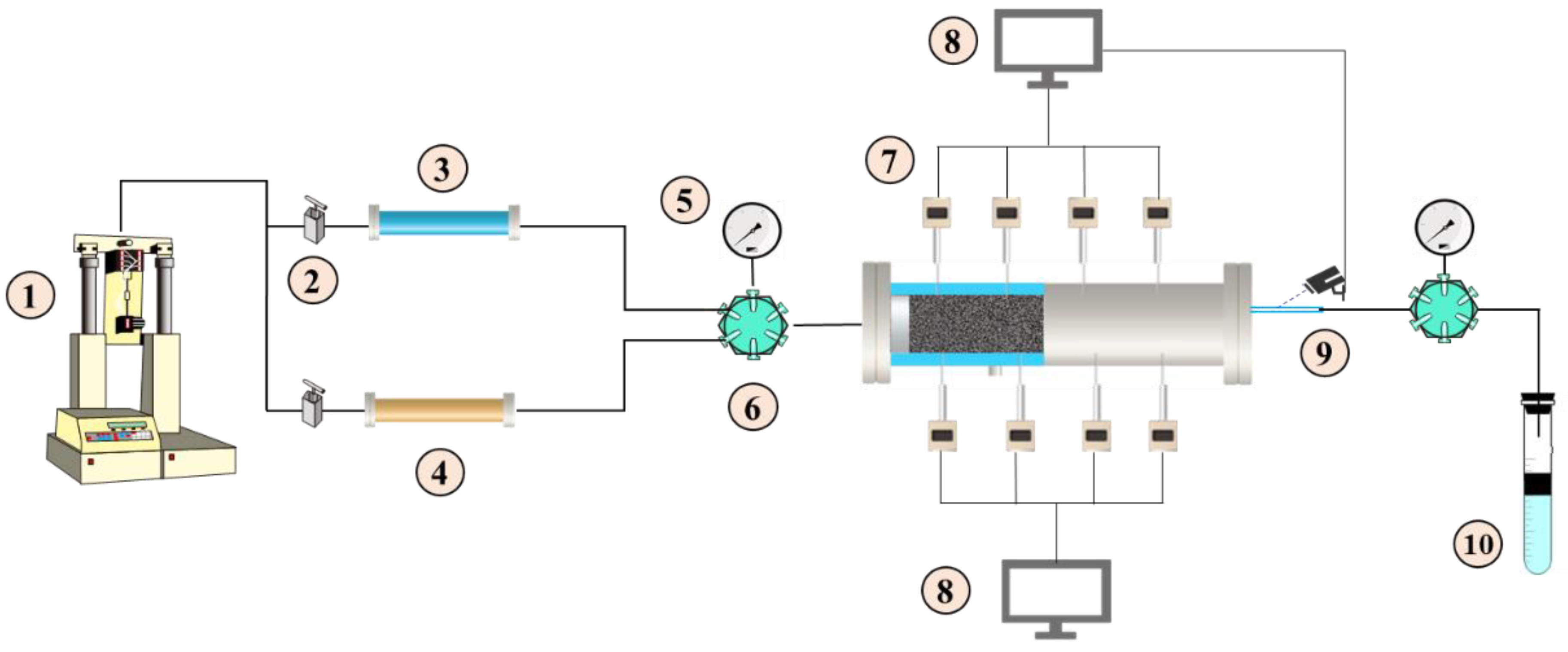

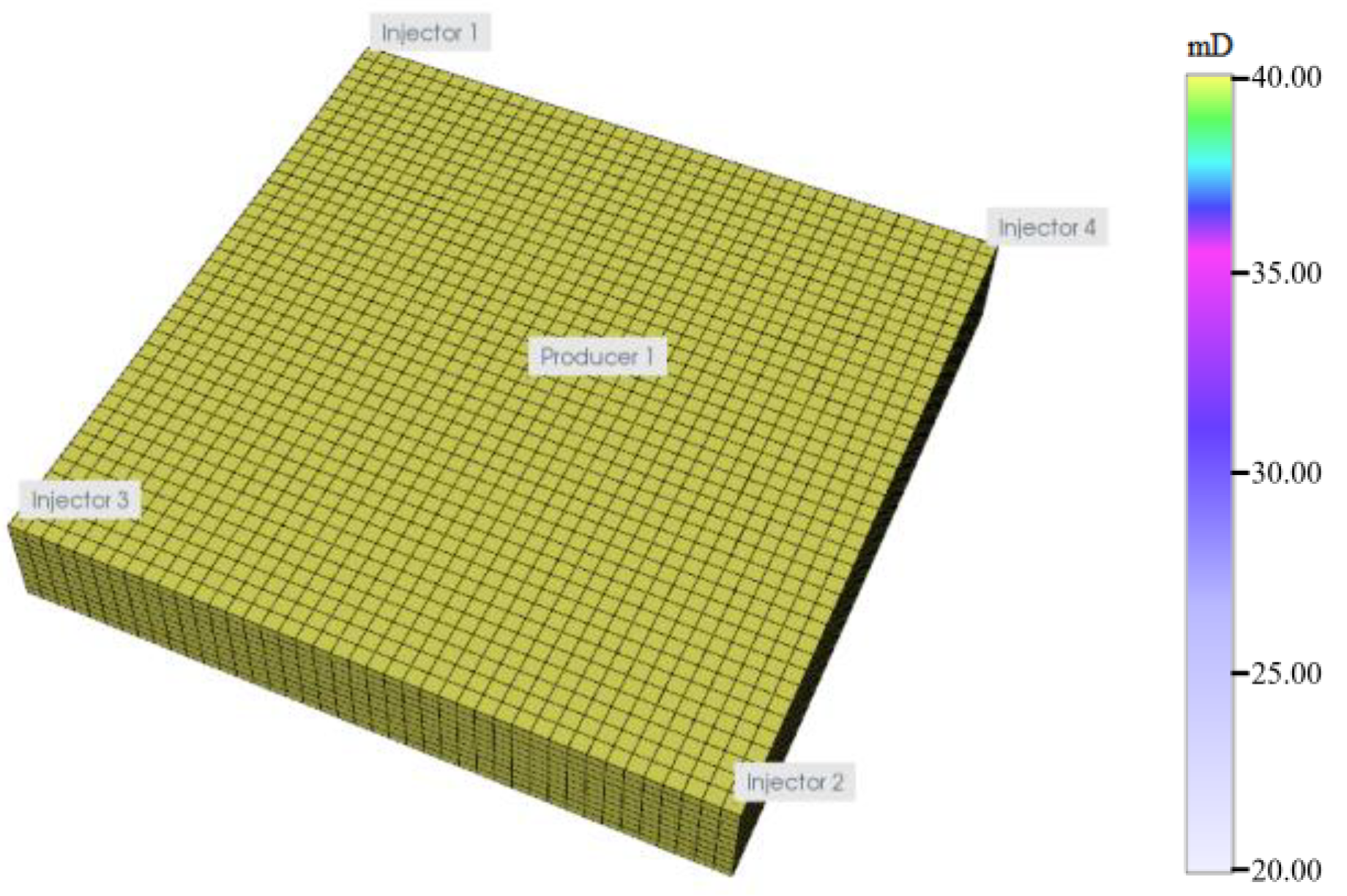
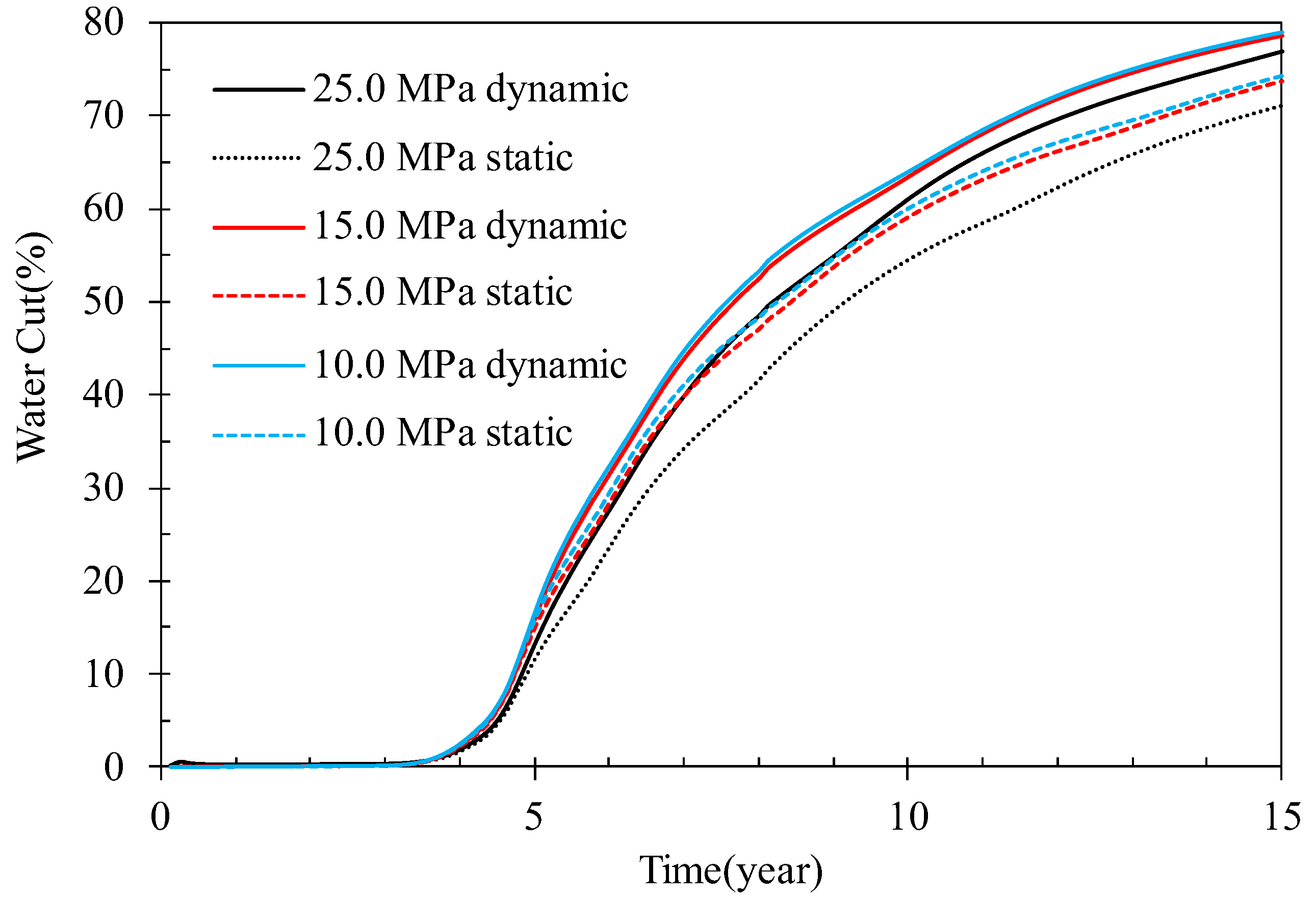
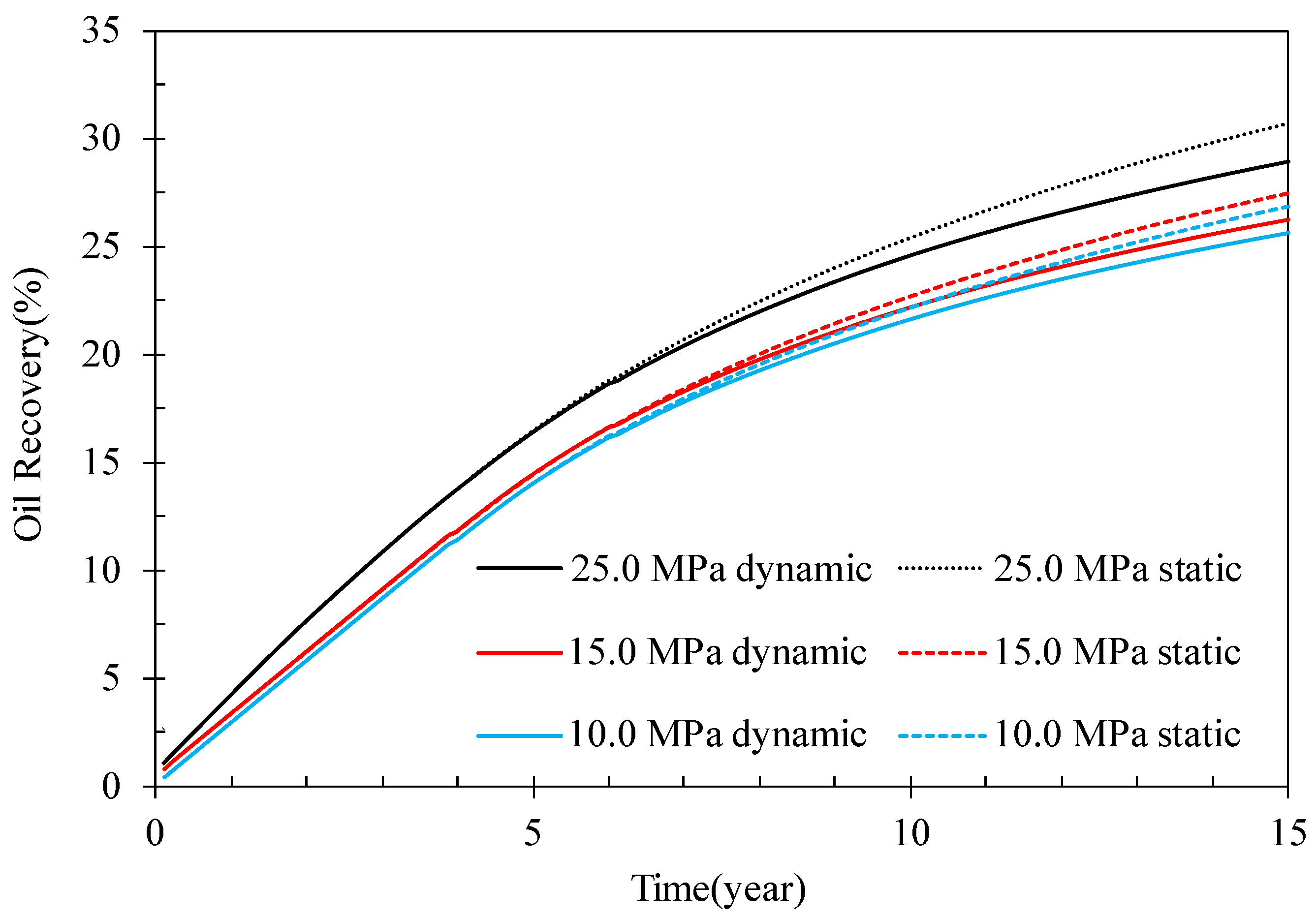

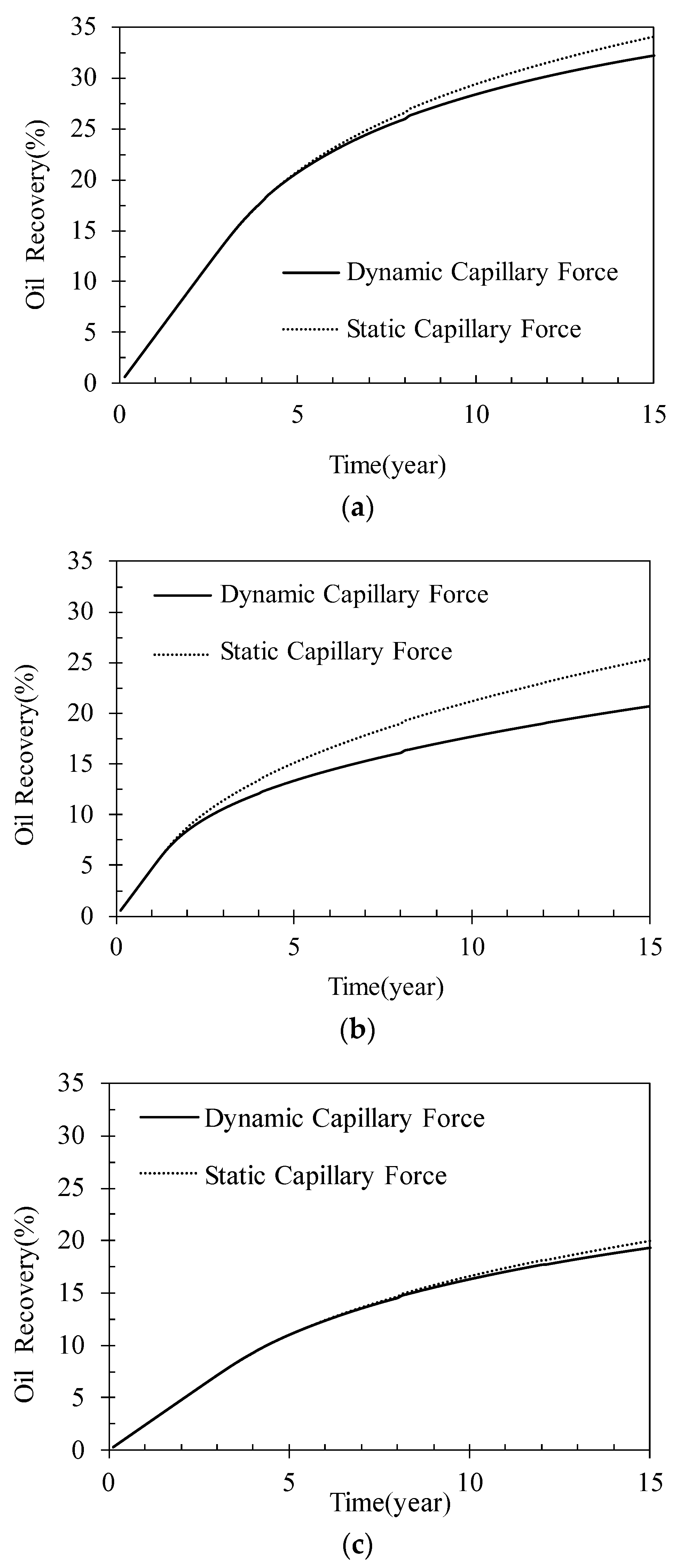
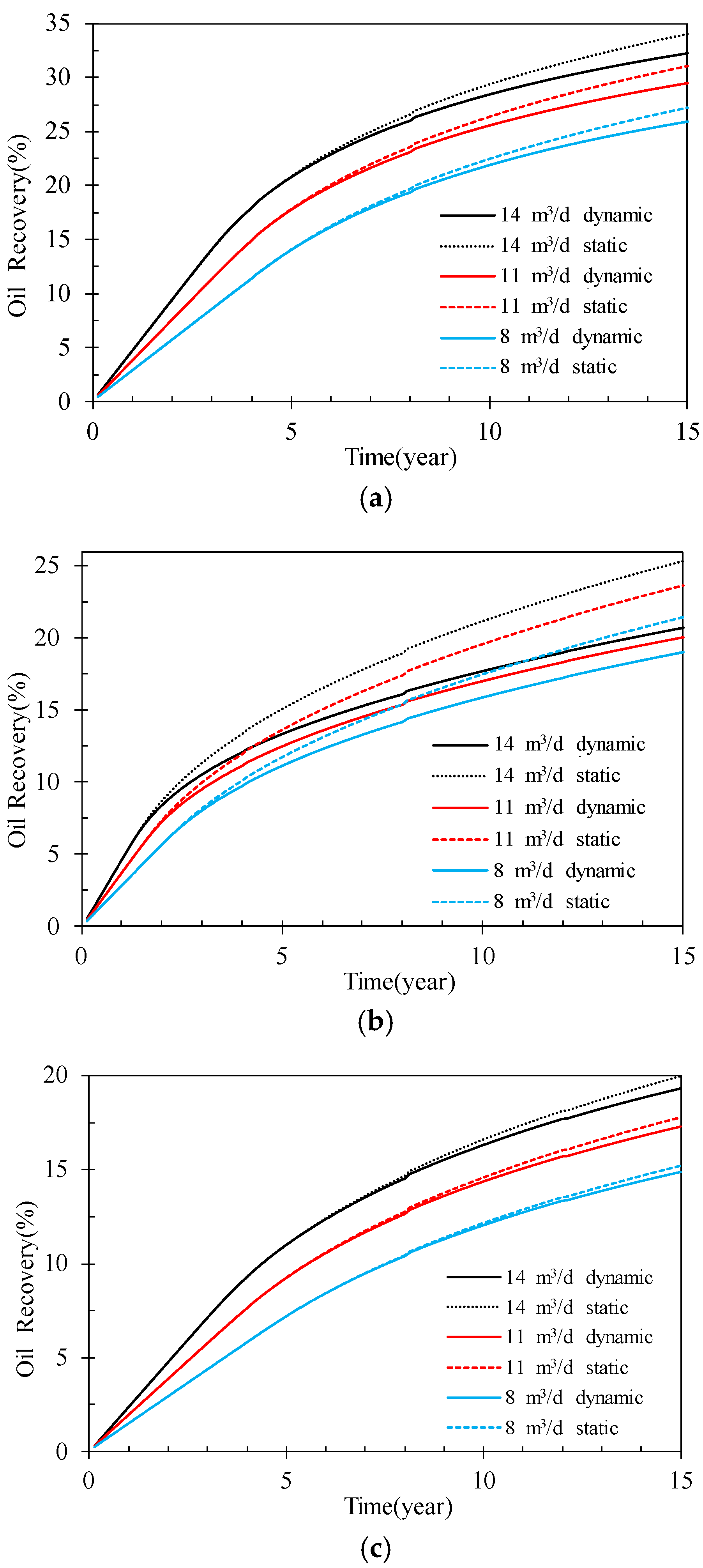
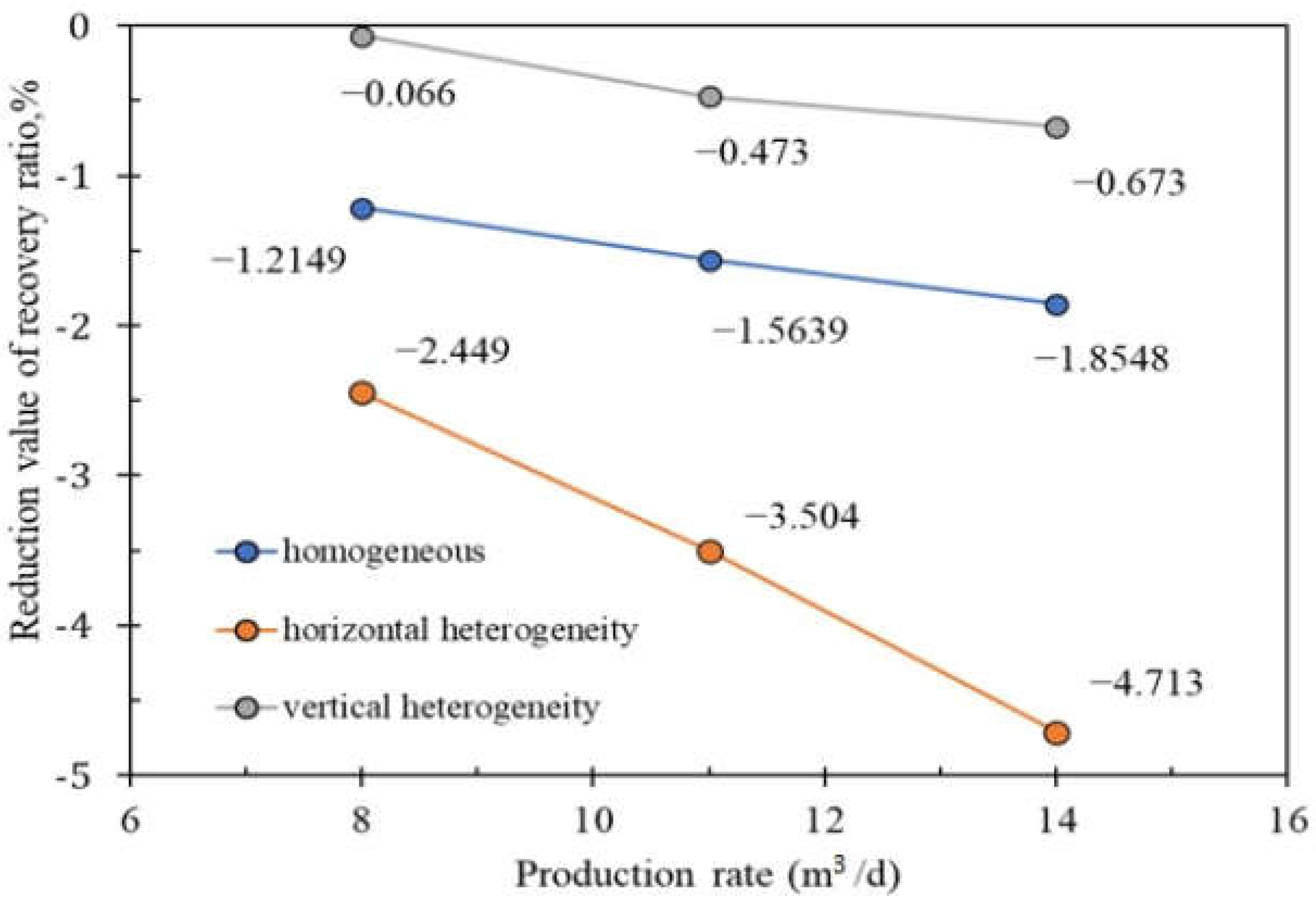
| Parameter | Value | Parameter | Value |
|---|---|---|---|
| Thickness of reservoir (m) | 10 | Oil viscosity (mPa·s) | 10 |
| Well spacing (m) | 200 | Formation water viscosity (mPa·s) | 1 |
| Porosity (%) | 20 | Initial oil saturation (%) | 85 |
| Permeability (mD) | 40 | Initial water saturation (%) | 15 |
| Parameters | Value | Parameters | Value |
|---|---|---|---|
| Horizontal permeability | 40.0 mD | Formation pressure | 10/15/25 MPa |
| Vertical permeability | 4.0 mD | Production velocity | 8.0 m3/d |
| Porosity | 20.0% | Injection velocity | 2.0 m3/d |
| Reservoir Parameters | Value | Reservoir Parameters | Value |
|---|---|---|---|
| Formation pressure (MPa) | 10 | High permeability (mD) | 40 |
| Well spacing (m) | 400 | Low permeability (mD) | 20 |
| Production rate (m3/d) | 14 | Porosity | 0.18 |
Disclaimer/Publisher’s Note: The statements, opinions and data contained in all publications are solely those of the individual author(s) and contributor(s) and not of MDPI and/or the editor(s). MDPI and/or the editor(s) disclaim responsibility for any injury to people or property resulting from any ideas, methods, instructions or products referred to in the content. |
© 2023 by the authors. Licensee MDPI, Basel, Switzerland. This article is an open access article distributed under the terms and conditions of the Creative Commons Attribution (CC BY) license (https://creativecommons.org/licenses/by/4.0/).
Share and Cite
Zhang, Y.; Wang, Y.; Gao, J.; Cui, Y.; Wang, S. Study of the Influence of Dynamic and Static Capillary Forces on Production in Low-Permeability Reservoirs. Energies 2023, 16, 1554. https://doi.org/10.3390/en16031554
Zhang Y, Wang Y, Gao J, Cui Y, Wang S. Study of the Influence of Dynamic and Static Capillary Forces on Production in Low-Permeability Reservoirs. Energies. 2023; 16(3):1554. https://doi.org/10.3390/en16031554
Chicago/Turabian StyleZhang, Yuanzhang, Youqi Wang, Jianwen Gao, Yuehua Cui, and Shuoliang Wang. 2023. "Study of the Influence of Dynamic and Static Capillary Forces on Production in Low-Permeability Reservoirs" Energies 16, no. 3: 1554. https://doi.org/10.3390/en16031554
APA StyleZhang, Y., Wang, Y., Gao, J., Cui, Y., & Wang, S. (2023). Study of the Influence of Dynamic and Static Capillary Forces on Production in Low-Permeability Reservoirs. Energies, 16(3), 1554. https://doi.org/10.3390/en16031554





